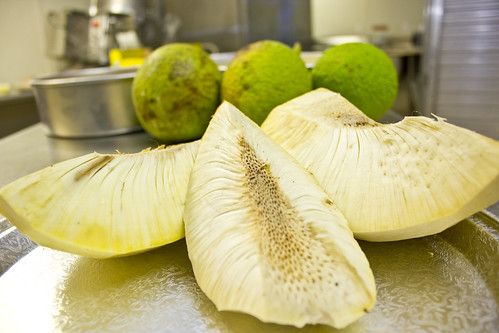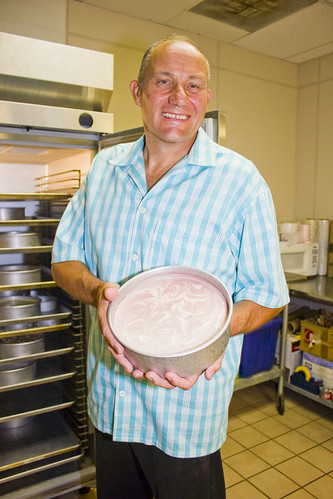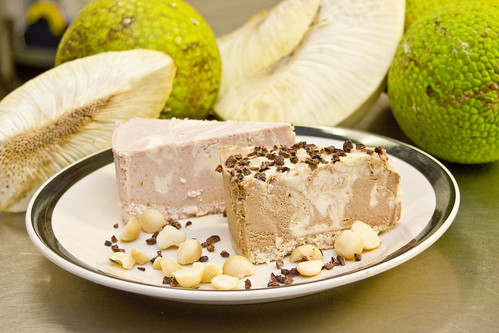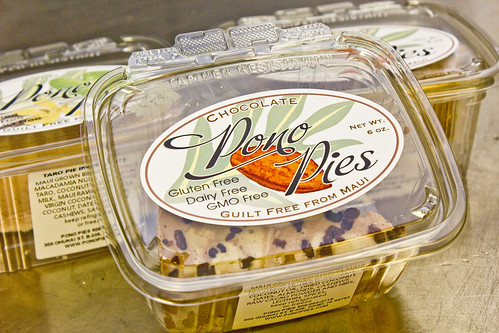We hear a lot about the need for food self sufficiency in Hawaii. The Department of Agriculture and Hawaii Economic Development Task force are working hard to address the issue, but their efforts often seem to get stuck in legislative politics. For instance, in the 2013 legislative session there was a bill to fund and establish an agricultural development and food security plan called the Food Resiliency Program. It seemed to have popular support but it ended up going nowhere, and was eventually shelved until the 2014 legislative session.
Ironically, the key to securing our state’s food supply may not in the future, but in the past. A century ago, the islands grew much of their own food. Pre-contact Hawaiian history shows the cultivation of considerable, and sustainable, staple foods. Now, a small group of people, comprised chiefly of botanists, chefs, farmers and community members, are looking to the past to find the keys to how that society fed its people. One of the answers, the researchers believe, is the ‘ulu (breadfruit).
“We harvested and distributed about 2,000 pounds of ‘ulu to social service agencies on the Big Island in the last year,” says Andrea Dean, of Hawaii Homegrown Food Network and the Ho‘oulu ka ‘Ulu project. “We have 25 key stakeholders in the Ho‘oulu ka ‘Ulu planning committee that represent 16 Hawaii nonprofit, university and government organizations. The three co-directors are Diane Ragone, Craig Elevitch and myself.”
Ragone, the director of the Breadfruit Institute of the National Tropical Botanical Garden (Kauai and Maui), Elevitch and Dean started the the Ho‘oulu ka ‘Ulu project in 2010 with the idea to revitalize the ‘ulu as an affordable and viable food. It’s nutritious, comes from attractive trees and is already part of Hawaiian cultural history. In fact, Kona and Lahaina were known for their ‘ulu trees. In the Kona region of West Hawaii, a cultivated Ulu forest could produce an estimated 36,000 tons of fruit every year. Now their initiative for West Hawaii has been identifying the existing and remaining trees in the area, making network connections with their owners and harvesting the fruit for the community.
“I do not know about other food security initiatives on Maui,” says Dean. “But I know there are some! Our mission is to revitalize the ‘ulu through our initiatives. More ‘ulu equals increased food security. We are not working on legislation–the Hawaii Food Policy Council on Oahu focuses on statewide policy.”
The Ho‘oulu ka ‘Ulu organization has been pursuing the ‘ulu in leaps and bounds since 2010. In 2012 the team published a breadfruit cookbook called Ho‘oulu ka ‘Ulu Cookbook: Breadfruit tips, techniques, and Hawai‘i’s favorite home recipes. Establishing a modern palate for breadfruit is key to the success of their plan.
They’ve held Breadfruit Festivals from 2011 to 2013 on Hawaii Island and Kauai. They’ve also developed a mobile app called Talking Trees that tells the story of breadfruit on the Big Island. Here on Maui, they’ve had a presence at the Maui County Ag Fest and East Maui Taro festival, and they also host the ‘Ulu Cookoff in Hana every October. This coming year, they’re kicking the year off with a Tree to Table workshop on breadfruit in the community service building at the University of Hawaii’s Maui campus on the morning of Jan. 9.
“The real issue that blows my mind is that this is a tree-crop, a simple plant to grow,” says Ian Cole from the Breadfruit Institute of the National Tropical Botanical Garden in Hana. “You shove it in the ground and basically walk away–with some minor care–and it produces hundreds of pounds of fruit on one tree. Look at the ridiculous inputs needed for sugar; look at the time-consuming nature of kalo; look at the infrastructure for hydroponic lettuce; look at the thousands of pounds of potatoes that come in via barge from Idaho. Every restaurant on this island (and state) serves potato fries when there is a viable and delicious, locally produced, non-GMO, gluten-free alternative. That alone is staggering.”
Cole says that he’s established a potato-free household, and that everyone else can, too. His upcoming “Tree to Table” presentation will talk about harvesting techniques, tricks, tools and what to do with your harvest. Ragone will also give a talk titled “Working with Variety” that covers all the basic breadfruit varieties in Hawaii. Ragone’s expertise comes from having contributed to the creation of the largest collection of breadfruit trees anywhere, located at the National Tropical Botanical Garden in Hana. Cole also works with that collection.
“Breadfruit was selected by the National Tropical Botanical Garden (NTBG) as its logo in the mid-1970s,” says Ragone. “At the same time, the NTBG decided to collect and curate ‘a definitive collection of breadfruit and breadnut’ recognizing the traditional importance of this crop in the Pacific islands and the need to collect and conserve breadfruit diversity. There was a need to conserve breadfruit diversity because of cultural and environmental factors resulting in loss of varieties and trees.”
The first 25 trees were planted at Kahunu Garden in the late 1970s. They were collected by NTBG staff in Samoa and French Polynesia. Ragone joined the project in the ‘80s as part of her PhD research with UH Manoa, and traveled to more than 50 islands to document traditional knowledge and cultural practices involving ‘ulu.
“The collection is valuable from a perspective of conservation, research, and education,” Ragone says. “We’ve conducted extensive research on the collection to better understand the varieties, such as time of production, nutritional composition, and identified good quality varieties to propagate and distribute for tree planting projects in Hawaii and globally. I’m interested in breadfruit for so many reasons: its cultural significance in the Pacific Islands; the richness of its horticulture and ethnobotany; its value for food security, health and nutrition.”
Chef John Cadman of Pono Pies is one of our island’s success stories on how to use Maui-grown breadfruit. He says he makes about 30 pies every week, with breadfruit, macadamia nuts from Waiehu and locally harvested honey. He also steams and peels about 100 pounds of local breadfruit, making them ready for use in the kitchens of Southside restaurants like Cafe O’Lei and Monkeypod Kitchen. His pies are for sale by the slice in Maui Coffee Roasters, Mana Foods, Down to Earth, Flatbread and even Tommy Bahama’s. You can also call him direct an order a whole pie. His latest product, Maui ‘Ulu Hummus, is nearly ready for sale.
“This is where the food movement should be going,” says Cadman. “Developing local sources and local value added products. I had an ingredient epiphany about a year ago. I saw this one little ‘ulu on the side of the road in Hana, and I didn’t pick it up. It really bothered me! So I went back picked it up, took it home and started making pie out of breadfruit.”
The product resulted in a silky, gluten-free, dairy-free Maui made pie that is catching on quick. Cadman says he loves to experiment with breadfruit, and he keeps discovering new ways to prepare it. For instance, his Maui ‘Ulu Hummus is made with local macadamia nuts, lemon juice and breadfruit, and the flavor is phenomenal.
On Jan. 9, his talk is titled “Beyond Sticky and Some like it Sweet.” During his time he’ll speak about the basic preparation of breadfruit and how to store it. In fact, he says that if you peel and steam it, you can freeze it for future use.
For this story, I scoured local farmers markets and supermarkets for a breadfruit to experiment with, but I couldn’t find any–a serious obstacle to the sustainable food effort. When I told Cole, he admitted that some obstacles remain.
“Consumers are definitely interested,” he says. “However, there are real challenges with this. People do not harvest at the right stage for a high quality fruit; people have only tasted Auntie’s recipe of boiled ‘ulu in coconut milk (and it’s not that good); people have no idea how to incorporate into their daily diet. That is one reason for this workshop series and one of our main goals. Education and encouraging the consumer and the grocer to demand high-quality. Unfortunately, the fruit does not do well on the shelf at the store. It rots quickly and will not ‘ripen’ once picked. It needs to be harvested and eaten within two to three days for best quality.”
Buying processed breadfruit might be the answer, but right now Maui simply needs more breadfruit trees. Cadman says he is maxed out right now at what he can do, and the island has no commercial growing operations. In fact, more commercial crops have been planted in the Caribbean to fight hunger, than here in Hawaii.
For Cadman’s part, he gets breadfruit from Kahanu Gardens when it’s available and has cultivated many personal relationships with breadfruit tree owners and backyard growers. “I trade a lot of pies for access to trees,” he says.
Ho‘oulu ka ‘Ulu and the Hawaii Homegrown Food Network anticipate that breadfruit production will increase over the next few years, and that means millions of potential dollars in sales. The upcoming community workshop will help Maui residents mobilize to take advantage of this drastically underused crop.
“The industry is small–expanding for sure–but small,” says Cole. “On Maui, there are only about three restaurants that have anything on their menu year-round made from breadfruit, and Pono Pies is the only value-added product. We talk to a lot of people about ‘ulu and everyone is excited but the number of people who’ve really made the jump and done something other than talk is few and far between.”
In fact, Cole says he’s gotten serious with friends and colleagues on this matter. “My big push lately has been accountability in consumption,” he says. “If you care about local food production, then why do you buy lettuce from Costco when it’s grown by local farmers? I’ve stopped cutting my colleagues and partners any slack in this regard. For example, I was recently approached by Travaasa Hana–they want to work together and do projects and host events. I asked them where they buy all of their produce and I told them flat out that I will not put my name or the Institute’s or the Garden’s on anything that could be considered a ‘dog and pony show,’ anything that is for PR, marketing purposes or anything that does not reflect their actual habits. If more people do not demand this change, we will not see it.”
Breadfruit From Tree to Table workshop
Thursday, Jan 9
8:30am-12pm
UH Maui Community Services Building
$12 (advance registration is required)
http://hawaiihomegrown.net/breadfruit-workshop.
For Andrea Dean’s Sustainable Initiatives website click the link.


























